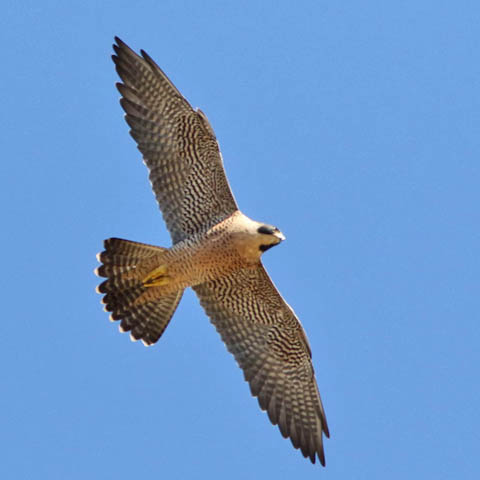| |
FALCONS & ALLIES Falconidae |
- 62 species worldwide
- DR personal total: 47 species (75%), 28 photo'd
|
|
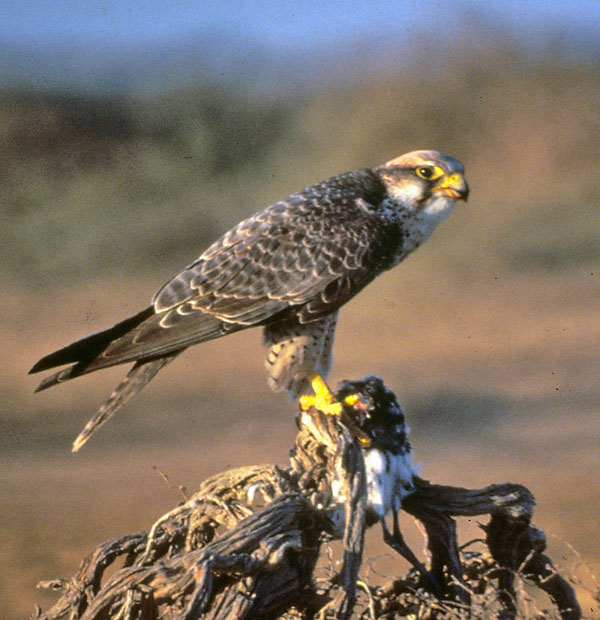 The
falcons of the world are fascinating to many people, both birders and
non-birders. They can be found almost anywhere on earth (except
Antarctica) and some species coexist well with humans. The sport of
falconry (using falcons to hunt gamebirds) goes back many centuries. I
suppose the fascination for many is the combination of speed and
elegant lines in a lethal predator. The Peregrine Falcon
is perhaps the most iconic of all — this one (above) has just caught an
American Coot and is busy flinging feathers to get to the meat. The
Peregrine's gorgeous dark color is consistent with the pealei race from northwestern North America. More on Peregrines is below. The
falcons of the world are fascinating to many people, both birders and
non-birders. They can be found almost anywhere on earth (except
Antarctica) and some species coexist well with humans. The sport of
falconry (using falcons to hunt gamebirds) goes back many centuries. I
suppose the fascination for many is the combination of speed and
elegant lines in a lethal predator. The Peregrine Falcon
is perhaps the most iconic of all — this one (above) has just caught an
American Coot and is busy flinging feathers to get to the meat. The
Peregrine's gorgeous dark color is consistent with the pealei race from northwestern North America. More on Peregrines is below.
Perhaps my "most memorable" falcon is the bird at left, a spectacular Lanner Falcon
at the tip of the Sinai Peninsula in November 1981 (the Sinai was then
Israeli occupied; it is now part of Egypt). It is particularly
memorable because although I took this photo, I have no memory of it. A
week before I had tumbled from a second-floor balcony and been knocked
unconscious; I was apparently air-lifted to a hospital by the army.
There is an entire blank week in my memory here, but I took extensively
field notes of my birding during the days after I returned. I also took
rolls of film. One roll starts with a close-up of a Bar-tailed Godwit,
then the next shot is a blur of brown feathers hitting to godwit, and
then a series of the falcon carrying it off to be devoured. Some of my
best stuff -- and my only recollections are these photos. It is a weird
feeling. |
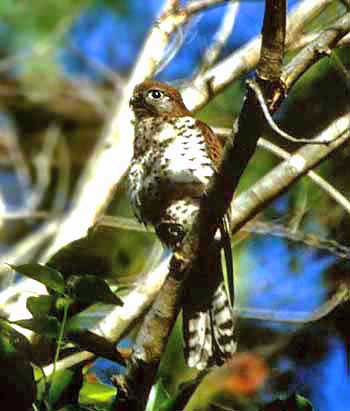 While the big falcons are glamorous and get all the ink, I am more emotional about the story of the Mauritius Kestrel
(right). Over the sorry history of man's destruction of birds and their
habitats, this is one of the best success stories going. When I first
began birding at a more active pace and my thoughts first turned to
world birding in 1974, this was considered the rarest bird in the
world. There were only two nesting pairs but two unmated individuals —
a total of just six birds — left in the world. But conservationists,
spearheaded by Tom Cade, Stanley Temple, C.G. Jones and others, got
international backing just in time. They developed a captive breeding
program and a public awareness campaign. By the publication of Cade's
(1982) Falcons of the World there were 15 in the wild; 1983
ten of those were captured for breeding (see Jones 1980 for more
details). The government of Mauritius also increased the sizes of
reserves. When I visited ten years later (1992) the program was going
so well there were 250 in the wild and many still being raised in
captivity. I understand the wild population is now up to 500 or so and
all available habitats on the island have been recolonized. Given this
dramatic history — an escape from extinction that passed through a
genetic bottleneck when numbers were so low — I still consider the
Mauritius Kestrel among the "best birds in the world" even though
today's birder need only visit Mauritius briefly to see one. While the big falcons are glamorous and get all the ink, I am more emotional about the story of the Mauritius Kestrel
(right). Over the sorry history of man's destruction of birds and their
habitats, this is one of the best success stories going. When I first
began birding at a more active pace and my thoughts first turned to
world birding in 1974, this was considered the rarest bird in the
world. There were only two nesting pairs but two unmated individuals —
a total of just six birds — left in the world. But conservationists,
spearheaded by Tom Cade, Stanley Temple, C.G. Jones and others, got
international backing just in time. They developed a captive breeding
program and a public awareness campaign. By the publication of Cade's
(1982) Falcons of the World there were 15 in the wild; 1983
ten of those were captured for breeding (see Jones 1980 for more
details). The government of Mauritius also increased the sizes of
reserves. When I visited ten years later (1992) the program was going
so well there were 250 in the wild and many still being raised in
captivity. I understand the wild population is now up to 500 or so and
all available habitats on the island have been recolonized. Given this
dramatic history — an escape from extinction that passed through a
genetic bottleneck when numbers were so low — I still consider the
Mauritius Kestrel among the "best birds in the world" even though
today's birder need only visit Mauritius briefly to see one.
|
|
Falcons
have been traditionally listed next to hawk and eagles [Accipitridae]
as closely related raptors. The concept that falcons are related to
hawks goes back in Linnaeus. White et al. (1994), in their Falconidae
chapter in the Handbook of Birds of the World, explain that
this relationship is still the "modern" approach. But that was before
the availability of genetic evidence. Ericson et al. (2006) and Hackett
et al. (2008) found that the Falconiformes are actually more closely
related to the Psittaciformes and Passeriformes than to any other
birds. They are now placed in their own Order, next to parrots, and are
not even remotely related to hawks and eagles. Wow, what a surprise
that was! Today, when one looks at a sleek and lovely falcon such as
the scarce Black Falcon of Australia (above), one might imagine it to be a giant predatory macaw.
Genetic
and morphological data (e.g., Griffiths et al. 2004, Fuchs et al. 2015)
indicate that there are three deep divisions in the Falconidae: the
caracaras and Spiziapteryx [Spot-winged Falconet to southern South America]; the forest-falcons (Micrastur and Herpetotheres [Laughing Falcon]); and the falcons (genus Falco plus Pygmy Falcon [Polihierax] and Old World falconets [Microhierax].
Fuchs et al. (2015) recognized each of the three as subfamilies.
Adopting that approach, here are the three subfamilies of the
Falconidae: |
|
|
|
|
Polyborinae
Caracaras & Spot-winged Falconet
Crested Caracara (above)
a vagrant in Santa Cruz Co., California
|
Herpetotherinae
Forest-Falcons & Laughing Falcon
Lined Forest-Falcon (above)
Manaus, Brazil, by Arthur Grosset
|
Falconinae
Falcons & Old World falconets
Amur Falcon (above)
Xianghai, China
|
|
|
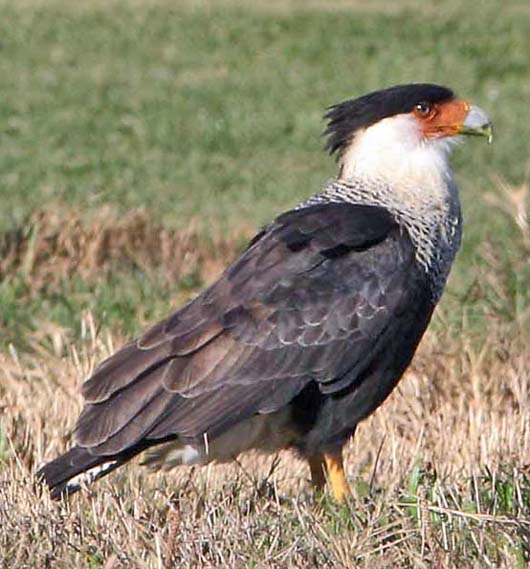 The
first two subfamilies mentioned are restricted to the New World. There
are nine species of caracaras in the Neotropics, ranging from humid
jungles to high elevation paramo. Some caracaras are forest edge
species, often following the rivers through the lowlands and hunting
along the banks. The Black Caracara (above) is such a
bird. It is widespread in the South American lowlands; here it uses
driftwood on a Napo River islet as a hunting post. The
first two subfamilies mentioned are restricted to the New World. There
are nine species of caracaras in the Neotropics, ranging from humid
jungles to high elevation paramo. Some caracaras are forest edge
species, often following the rivers through the lowlands and hunting
along the banks. The Black Caracara (above) is such a
bird. It is widespread in the South American lowlands; here it uses
driftwood on a Napo River islet as a hunting post.
Several caracaras occur in open or arid habitats. Here, they can be conspicuous. The Crested Caracara
(right) is the northernmost species and ranges into the southern U.S.
from Texas to Florida. Vagrants wander widely, including this
photographed adult at the edge of a famed Pebble Beach, Monterey Co.,
California, golf course (right).
Widespread in the llanos and open country of South America is Southern Caracara
(below), seen taking a bath in an ephemeral rain pool on the Brazilian
pantanal. Southern Caracara was split from Northern Caracara
comparatively recently, their ranges divided by the Amazon River (Dove
& Banks 1999). Both are very much birds of open country and readily
willing to take carrion as well as hunting a wide variety of lizards,
snakes, and turtles, or to plunder the nests of small birds. |
|
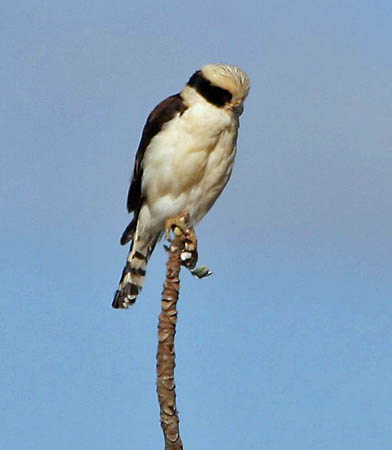 The
8 species of forest-falcons are mostly shy birds of the forest
interior. Depending on the size of the species, they hunt for insects
and lizards to large birds and small mammals. The only member within
this subfamily not called a "forest-falcon" is the conspicuous and
striking Laughing Falcon (left). It is a forest edge
species that typical hunts from a high, open perch. They feed almost
exclusively on snakes, both terrestrial and arboreal, including large
and venomous ones (White et al. 1994). The
8 species of forest-falcons are mostly shy birds of the forest
interior. Depending on the size of the species, they hunt for insects
and lizards to large birds and small mammals. The only member within
this subfamily not called a "forest-falcon" is the conspicuous and
striking Laughing Falcon (left). It is a forest edge
species that typical hunts from a high, open perch. They feed almost
exclusively on snakes, both terrestrial and arboreal, including large
and venomous ones (White et al. 1994).
Hilty (2003)
says this species is "Well named for its tireless, laugh-like call
heard mostly in early morning or late evening, occasionally even after
dark. Typically a long, far-carrying, and lamenting tirade, 'gua-co, gua-co,'
lasting several minutes, often increasing somewhat in tempo and
becoming more rhythmic as it goes along. A calling bird is often joined
by its mate, and the notes of the two alternately syncopated,
simultaneous, or out of sequence in a long-drawn, slowly accelerating
cacophony suggesting maniacal laughter."
The
remaining 45 species in the Falconidae are in the subfamily Falconinae,
the more typical falcons. There is quite a size variation in this
subfamily, from two species of genus Polihierax) — Pygmy Falcon in Africa and White-rumped Falcon P. insignis of southeast Asia —and five Old World falconets (genus Microhierax),
all ranging between 30-75 grams in weight, to the huge Gyrfalcon of the
Arctic (large females up to 2100 grams!). Below are photos of the very
tiny Pygmy Falcon (left, from the Kalahari Desert, South Africa) and a very large Gyrfalcon (a vagrant to Idaho in Feb ). |
|
|
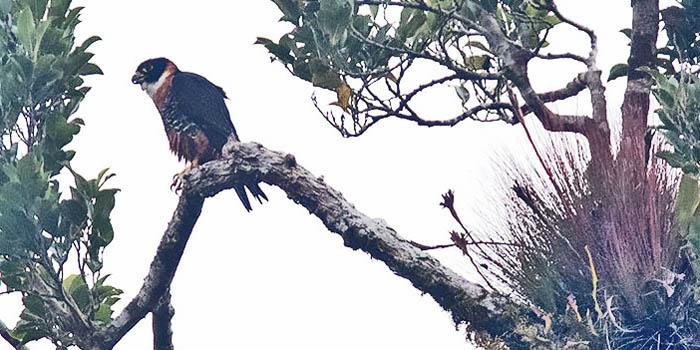 I'm a big fan of the small, fast, mostly bird-hunting falcons, like Merlin
(above). This one was at Pt. Pinos and was just taking flight as a huge
wave crashed behind it, creating the massive spray behind. It is of the
dark northwestern North American race suckleyi, which winters here in Monterey County in small numbers. I'm a big fan of the small, fast, mostly bird-hunting falcons, like Merlin
(above). This one was at Pt. Pinos and was just taking flight as a huge
wave crashed behind it, creating the massive spray behind. It is of the
dark northwestern North American race suckleyi, which winters here in Monterey County in small numbers.
In the Neotropics, such a small fast aerial-hunting falcon is Bat Falcon
(right, in a fine shot by Arthur Grosset from Guatemala). There are
places this species is crepuscular and takes a lot of bats, but
elsewhere it is a bird-hunter of extensive primary forests. |
| In Africa such a dapper, fast-flying, bird-eating falcon is Red-necked Falcon
(below left, a pair digiscoped in Ghana; the smaller male is upper
right in the shot); it also occurs in India. At high elevations in New
Guinea such a falcon could be Australasian Hobby
(below right, taken a long time ago in the Baliem Valley of then "Irian
Jaya," Indonesia). It is quite wonderful to have a fine variety of
strikingly beautiful small falcons around the globe. |
|
|
|
Among
the falcons, some 13 species are called kestrels. These are small
falcons and some (but not all) focus primarily on taking insects.
Kestrels occur in (usually) open country on all the major continents,
ranging from Gray Kestrel in central and southern Africa (far left) to American Kestrel
(near left), widespread from Canada to northern South America and the
Caribbean. This particular American Kestrel is an adult female of the
widespread nominate race. There is a fair bit of variation in plumage
among Caribbean populations. |
|
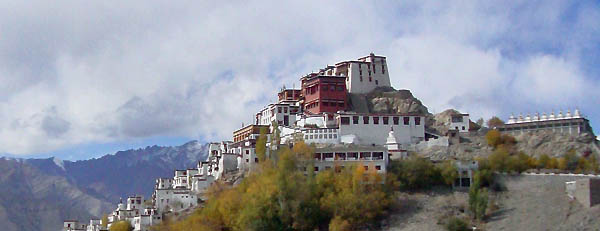 And
finally we are back of the big impressive falcons. Picture yourself at
this colorful Buddhist monastery high in the Himalayas of India
(Thiksey Gompa, right), near the border of Tibet. Your are at 11,800'
elevation (3600m); the air is cold and crisp; and you are ringed by
snowy mountains. A flock of feral Rock Pigeons circle the monastery,
but they scatter wildly as a huge Saker Falcon flashes past (two photos below). This is the second-largest falcon; it inhabits the wilds of central Asia. And
finally we are back of the big impressive falcons. Picture yourself at
this colorful Buddhist monastery high in the Himalayas of India
(Thiksey Gompa, right), near the border of Tibet. Your are at 11,800'
elevation (3600m); the air is cold and crisp; and you are ringed by
snowy mountains. A flock of feral Rock Pigeons circle the monastery,
but they scatter wildly as a huge Saker Falcon flashes past (two photos below). This is the second-largest falcon; it inhabits the wilds of central Asia. |
|
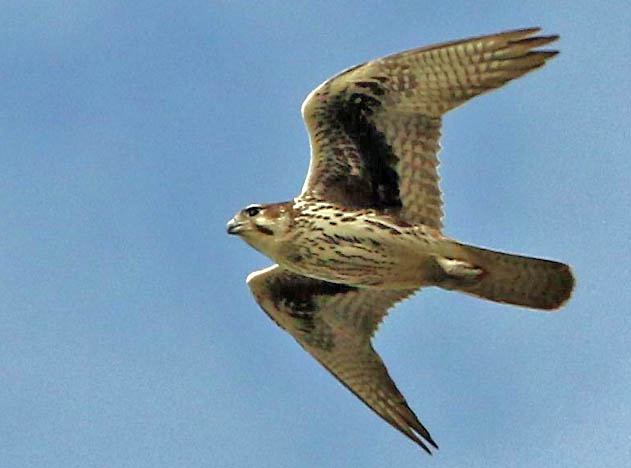 Halfway around the world, in the United States, the large falcon of the "big sky country" of the American west is Prairie Falcon
(left). A few breed in the interior of my home Monterey County,
California, but more arrive in winter from the cold interior of the
Great Basin. Halfway around the world, in the United States, the large falcon of the "big sky country" of the American west is Prairie Falcon
(left). A few breed in the interior of my home Monterey County,
California, but more arrive in winter from the cold interior of the
Great Basin.
The best known falcon is the Peregrine
which, if I'm not mistaken, has the most extensive range of any bird
species in the world. It is a magnificent hunter, dropping from the
skies at high speeds on its prey. Peregrines prey heavily on shorebirds
and waterfowl along the coast and at waterfowl refuges (the top photo
of this web page shows a Peregrine eating a coot on the shores of San
Francisco Bay). In cities around North America, the prey is mostly on
non-native Rock Doves (feral pigeons). There the Peregrine has adapted
to city life by nesting on skyscraper ledges or bridge girders which
replicate the conditions of the steep, inaccessible cliffs it uses for
breeding in the wilderness. |
In
the United States, Peregrines were once more widespread and reasonably
common but the species suffered precipitous continental declines in the
1960s and early 1970s due to pesticides, shooting, and nest-robbing for
falconry. The widespread use of the pesticide DDT caused eggshell
thinning; thin eggs easily broke and eventually nest sites were
abandoned. By the early 1970s only one pair was known to nest in the
California.
In my home county (Monterey)
Peregrines had historically been known at some 24 nest sites but the
last site was abandoned in the mid-1960s. Fortunately the banning of
DDT and governmental listing as an Endangered species, aided
tremendously by a hands-on recovery program, have returned the
Peregrine to a stable healthy population. The recovery effort was
spearheaded in the late 1970s and 1980s by the Santa Cruz Predatory
Bird Research Group who removed thin-shelled eggs from nests for safe
hatching in captivity, returned young to nests and then closely
monitored their success. The Ventana Wilderness Society also released
captive-reared birds from a hack site above the Big Sur coast beginning
in 1986. By 1980 there were again five Monterey County nests occupied
that fledged 4 young. The active intervention phase of Peregrine Falcon
management ended in my county about 1990.
[A Peregrine Falcon in Monterey County recently, right) |
|
|
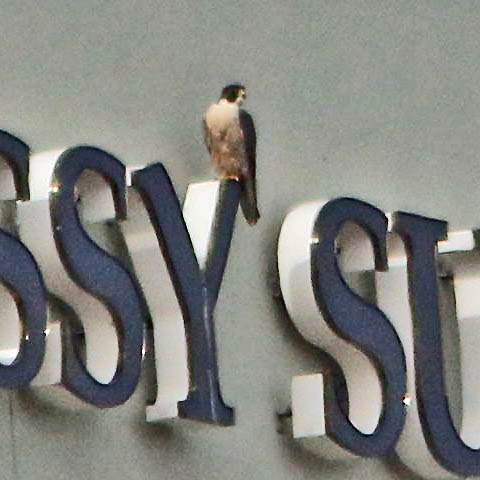
With
these management efforts the local breeding population has rebounded;
today there are 6-9 nests from Hurricane Pt. south to the San Luis
Obispo Co. line, and it is possible that traditional interior sites
have been or will be reclaimed. Today, a resident Peregrine or two
hunts the feral pigeons at Fisherman's Wharf and Cannery Row. To
paraphrase the great parody of Tom Lehrer: "surely its not against
religion — to prey upon a pigeon!" All hail the return of the Peregrine!
The
above discussion about the return of the Peregrine was cut-and-pasted
from the initial web page on Falconidae written back in 2000, which was
18 years ago as of this update. Now, Peregrines continue to breed
widely along the Big Sur coast and in remote parts of the Monterey
County interior. On the Monterey Peninsula, a Peregrine Falcon or two often sit on the huge sign for Embassy Suites 12-story hotel (left). |
| |
Photos: The Peregrine Falcon Falcon peregrinus, of the race pealei, was plucking a coot at Mountain View, California, on 8 Nov 2008. The Lanner Falcon Falco biarmicus was photographed on 6 Nov 1981 at Sharm-el-sheik, Sinai. The Mauritius Kestrel Falco punctatus was in the Black River gorge, Mauritius, on 5 Dec 1992. The Black Falcon Falco subniger was along the Birdsville Track, South Australia, on 20 Nov 2009. The flying Crested Caracara Caracara cheriway was near Davenport, Santa Cruz Co., CA, on 30 Oct 2005. The Lined Forest-Falcon Micrastur gilvicollis was photographed by Arthur Grosset in Manaus, Brazil, in Sep 2003. The Amur Falcon Falco amurensis was at Xianghai, China, on 13 June 2004. The Black Caracara Daptrius ater was along the Napa River near La Selva, Ecuador, in April 1992. The adult Crested Caracara Caracara cheriway was at Pt. Joe, Pebble Beach, CA, on 30 Dec 2006. The bathing Southern Caracara Caracara plancus was on the Brazilian Pantanal on 19 July 2010, and the Laughing Falcon Falco biarmicus was perched along the Rio Claro nearby that date. The Pygmy Falcon Polihierax semitorquatus was in the Gemsbok-Kalahari NP, South Africa, on 11 July 2005. The Gyrfalcon Falco rusticolus was near Gannett, Idaho, on 31 Jan 1997. The black suckleyi Merlin Falco columbarius in flight was at Pt. Pinos, Monterey Co., CA, on 11 Nov 2015. The Bat Falcon Falco rufigularis was photographed by Arthur Grosset in Guatemala in July 2015. The pair of Red-necked Falcon Falco chicquera was digiscoped in Mole NP, Ghana, on 12 Dec 2013. The distant The Australasian Hobby Falco longipennis was in the Baliem Valley, Papua Prov., Indonesia, on 2 Aug 1994. The Gray Kestrel Falco ardosiaceus was at Murchison Falls NP, Uganda, on 28 July 2002. The American Kestrel Falco sparverius was near Pt. Sur, CA, on 5 Nov 2016. The Saker Falcon Falco cherrug and the Thiksey Gompat monastery were photographed near Leh, India, on 29 Oct 2014. The flying Prairie Falcon Falco mexicanus was at Peachtree Valley, Monterey Co., CA, on 11 Nov 2016. The soaring The soaring Peregrine Falcon Falco peregrinus, of the race anatum,
was at the Salinas R. mouth, Monterey Co., on 25 Sep 2016, and the one
perched on Embassy Suites, Seaside, CA, was on 19 Mar 2016.
Photos © Don Roberson and © Arthur Grosset, as credited, and used with permission; all rights reserved.
Family book: Rating 
Cade, T. J. 1982. The Falcons of the World. Cornell Univ. Press, Ithaca, N.Y.
I
admit to an inordinate fondness for this book despite its many
drawbacks. It is a "popular" work that lacks the depth of more recent
family books. It does not try to tackle field identification and does
not have details of plumages. The range maps are stuffed together in
the back rather than in the species accounts, a a very annoying defect.
Yet I just love the primary approach of this book — an overview of each
species by an acknowledged expert, written in lucid and entertaining
fashion with much information about behavior and habitat, together with
full page quality paintings of each species in its habitat. The art is
by R. David Digby and I find it very pleasing, even if it lacks the
detail of background vegetation of, say, an Eckelberry, or a Peterson,
or a Bateman. Those plates showing a falcon with prey are particularly
evocative. This volume is now almost 20 years old and is obviously
quite dated. The high marks (4 of 5 stars) are for its concept — well
executed — even if we need something newer for serious reference. Even
in 1982, I recall being disappointed that the "Pallid" or
"Kleinschmidt's" Falcon had a full species account since the text
well-explained that it appeared to be a rare, recessive color morph of
the Peregrine. The text concluded that "this may be the last time for
the name Falco kreyenborgi to appear at the head of a species
account;" this turned out to be accurate. I wanted the author to "bite
the bullet" and delete this "species" from his list at that point. Yet,
on the other hand, what a magnificent painting accompanies the
misbegotten text! Despite being dated, the text is well-researched;
appropriate citations do not overwhelm the stories told; and the
information appears accurate. I wish we had more family books like this
one.
Family book: Rating 
Brown, Leslie, and Dean Amadon. 1968. Eagles, Hawks, and Falcons of the World. 2 vols. McGraw-Hill, New York.
When
this two-volume boxed set came out in the late 1960s, it was the state
of the art on knowledge of the world's raptors. It covered hawks &
eagles, plus falcons and the monotypic families of Osprey and
Secretarybird. The authors were renowned experts on the subject; the
text was reasonably thorough and the range maps up-to-date (for the
time), and every species was pictured on full-page plates showing one
to a half-dozen birds. Sometimes these were six species together; on
other plates it showed age/sex variation, or color morphs, or
subspecies. Eight artists were included, among them legendary names
like Roger Tory Peterson (Old World vultures), Don Eckelberry (large
falcons, including full page paintings of birds like an Indian
Peregrine perched against the backdrop of Rangaswami's Pillow — a
fantastic rock formation in south India), A. E. Gilbert (great tropical
raptors) and D.M. Henry (his plate of variation in Gyrfalcon is
superb), and Guy Coheleach (a variety of eagles and Buteos). J. C.
Harrison seems to have done most of the lesser-known species... the
"grunt work" as it were (and a good number are printed in
black-and-white). In a book like this, the differences in artistic
style is almost welcomed; these are not "field guide" art to be
compared one to another, but a collection of great artwork combined
with an authoritative text. All that having been said, the classic work
is now showing its age. Much has been learned in the last
quarter-century about ranges; about status; about biology and taxonomy
and identification. Yet in many respects Brown & Amadon's
achievement stands the test of time. It is still a primary reference
work on the world's raptors, and their taxonomic comments (especially
at the species level) are still entitled to much deference. I give it
high marks as a "classic." There are regional works to which one turns
much more readily for identification material. In North America, the
best work is Wheeler & Clark (1995) whose set of color photos show
much more of the range of variation present in Nearctic raptors than
anything else at the time of this review (in the 1990s). Beginners,
however, are well advised to obtain and read Dunne, Sibley & Sutton
(1988) that captures in words and line drawings the essential shape
characteristics of common (but confusing) species. In Europe and the
Middle East, I have found Porter et al. (1981) very useful, but there
is a new book by Dick Forsman (1999) that is a major advance on western
Palearctic raptors.
Literature cited:
Dove, C. J., and R. C. Banks. 1999. A taxonomic study of crested caracaras (Falconidae). Wilson Bull. 111: 330-339.
Dunne, P., D. Sibley, and C. Sutton. 1988. Hawks in Flight. Houghton Mifflin, Boston.
Ericson,
P.G.P., C.L. Anderson, T. Britton, A. Elzanowski, U.S. Johansson, M.
Kallerrsjo, J.I. Ohlson, T. J. Partson, D. Zuccon, and G. Mayr. 2006.
Diversification of Neoaves: integration of molecular sequence data and
fossils. Biol. Letters 2: 543-547.
Forsman, D.
1999. The Raptors of Europe and the Middle East: a Handbook of Field
Identification. T. & A.D. Poyser, London.
Fuchs,
J., J.A. Johnson, and D.P. Mindell. 2015. Rapid diversification of
falcons (Aves: Falconidae) due to expansion of open habitats in the
Late Miocene. Molec. Phylog. Evol. 82: 166-182.
Griffiths,
C.S., G.F. Barrowclough, J.C. Groth, and L. Mertz. 2004. Phylogeny of
the Falconidae (Aves): a comparison of the efficacy of morphological,
mitochondrial, and nuclear data. Molec. Phylog. Evol. 309: 101-109.
Hackett,
S.J., R.T. Kimball, S. Reddy, R.C.K. Bowie, E. L. Braun, M. J. Braun,
J.L. Chojnowski, W. A. Cox, K.-L. Han, J. Harshman, C.J. Huddleston,
B.D. Marks, K.J. Miglia, W.S. Moore, F.H. Sheldon, D.W. Steadman, C. C.
Witt, and T. Yuri. 2008. A phylogenomic study of birds reveals their
evolutionary history. Science 320: 1763-1768
Hilty, S.L. 2003. Birds of Venezuela, 2d ed. Princeton Univ. Press, Princeton, N.J.
Jones, C. G. 1980. The Mauritius Kestrel, its biology and conservation. Hawk Trust Annual Rpt. 10: 18-29.
Mountfort, G. 1988. Rare Birds of the World: A Collins/ICBP Handbook. Stephen Greene Press, Lexington, MA.
Porter,
R. F., I. Willis, S. Christensen, and B. P. Nielsen. Flight
Identification of European Raptors. 3d ed. 1981. P. & A.D. Poyser,
Calton, England.
Wheeler, B.K., and W.S. Clark. 1987. A Photographic Guide to North America Raptors. Academic Press, San Diego CA.
White, C.M., P.D. Olsen, and L.F. Kiff. 1994. Family Falconidae (Falcons and Caracaras), pp. 216 –277 in Handbook of the Birds of the World (del Hoyo, J., A. Elliott & J. Sargatal, eds). Vol. 2. Lynx Edicions, Barcelona, Spain.
|
|
|

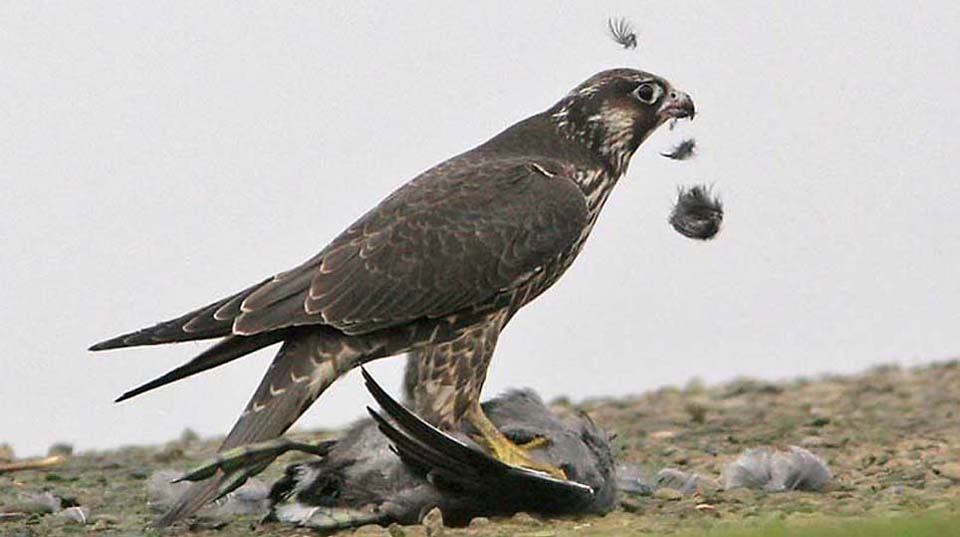

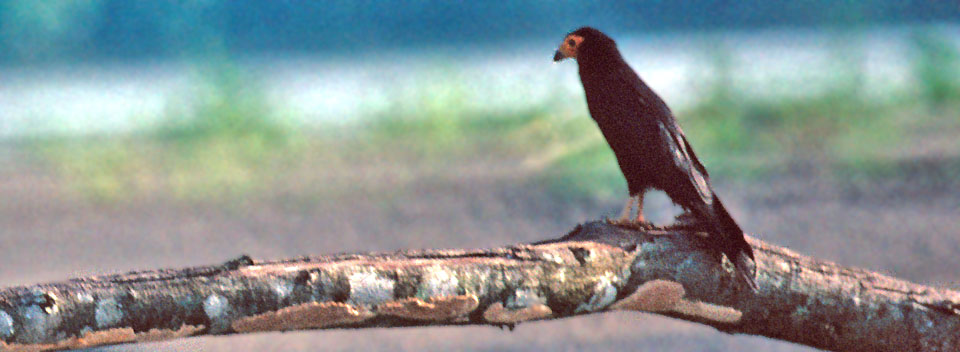
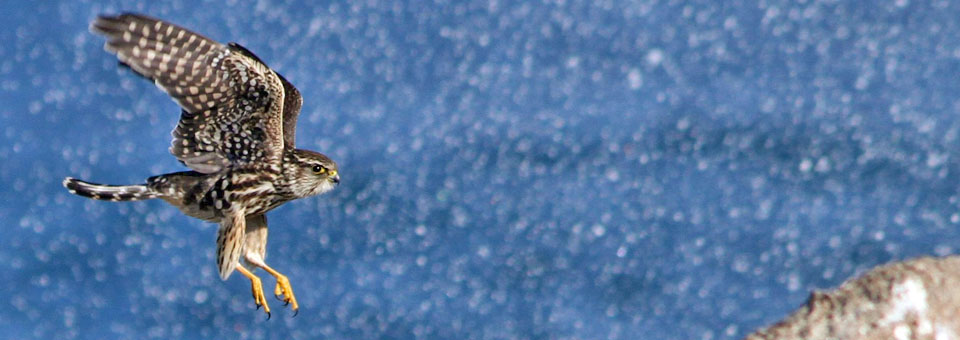
 And
finally we are back of the big impressive falcons. Picture yourself at
this colorful Buddhist monastery high in the Himalayas of India
(Thiksey Gompa, right), near the border of Tibet. Your are at 11,800'
elevation (3600m); the air is cold and crisp; and you are ringed by
snowy mountains. A flock of feral Rock Pigeons circle the monastery,
but they scatter wildly as a huge Saker Falcon flashes past (two photos below). This is the second-largest falcon; it inhabits the wilds of central Asia.
And
finally we are back of the big impressive falcons. Picture yourself at
this colorful Buddhist monastery high in the Himalayas of India
(Thiksey Gompa, right), near the border of Tibet. Your are at 11,800'
elevation (3600m); the air is cold and crisp; and you are ringed by
snowy mountains. A flock of feral Rock Pigeons circle the monastery,
but they scatter wildly as a huge Saker Falcon flashes past (two photos below). This is the second-largest falcon; it inhabits the wilds of central Asia.  The
falcons of the world are fascinating to many people, both birders and
non-birders. They can be found almost anywhere on earth (except
Antarctica) and some species coexist well with humans. The sport of
falconry (using falcons to hunt gamebirds) goes back many centuries. I
suppose the fascination for many is the combination of speed and
elegant lines in a lethal predator. The Peregrine Falcon
is perhaps the most iconic of all — this one (above) has just caught an
American Coot and is busy flinging feathers to get to the meat. The
Peregrine's gorgeous dark color is consistent with the pealei race from northwestern North America. More on Peregrines is below.
The
falcons of the world are fascinating to many people, both birders and
non-birders. They can be found almost anywhere on earth (except
Antarctica) and some species coexist well with humans. The sport of
falconry (using falcons to hunt gamebirds) goes back many centuries. I
suppose the fascination for many is the combination of speed and
elegant lines in a lethal predator. The Peregrine Falcon
is perhaps the most iconic of all — this one (above) has just caught an
American Coot and is busy flinging feathers to get to the meat. The
Peregrine's gorgeous dark color is consistent with the pealei race from northwestern North America. More on Peregrines is below. While the big falcons are glamorous and get all the ink, I am more emotional about the story of the Mauritius Kestrel
(right). Over the sorry history of man's destruction of birds and their
habitats, this is one of the best success stories going. When I first
began birding at a more active pace and my thoughts first turned to
world birding in 1974, this was considered the rarest bird in the
world. There were only two nesting pairs but two unmated individuals —
a total of just six birds — left in the world. But conservationists,
spearheaded by Tom Cade, Stanley Temple, C.G. Jones and others, got
international backing just in time. They developed a captive breeding
program and a public awareness campaign. By the publication of Cade's
(1982) Falcons of the World there were 15 in the wild; 1983
ten of those were captured for breeding (see Jones 1980 for more
details). The government of Mauritius also increased the sizes of
reserves. When I visited ten years later (1992) the program was going
so well there were 250 in the wild and many still being raised in
captivity. I understand the wild population is now up to 500 or so and
all available habitats on the island have been recolonized. Given this
dramatic history — an escape from extinction that passed through a
genetic bottleneck when numbers were so low — I still consider the
Mauritius Kestrel among the "best birds in the world" even though
today's birder need only visit Mauritius briefly to see one.
While the big falcons are glamorous and get all the ink, I am more emotional about the story of the Mauritius Kestrel
(right). Over the sorry history of man's destruction of birds and their
habitats, this is one of the best success stories going. When I first
began birding at a more active pace and my thoughts first turned to
world birding in 1974, this was considered the rarest bird in the
world. There were only two nesting pairs but two unmated individuals —
a total of just six birds — left in the world. But conservationists,
spearheaded by Tom Cade, Stanley Temple, C.G. Jones and others, got
international backing just in time. They developed a captive breeding
program and a public awareness campaign. By the publication of Cade's
(1982) Falcons of the World there were 15 in the wild; 1983
ten of those were captured for breeding (see Jones 1980 for more
details). The government of Mauritius also increased the sizes of
reserves. When I visited ten years later (1992) the program was going
so well there were 250 in the wild and many still being raised in
captivity. I understand the wild population is now up to 500 or so and
all available habitats on the island have been recolonized. Given this
dramatic history — an escape from extinction that passed through a
genetic bottleneck when numbers were so low — I still consider the
Mauritius Kestrel among the "best birds in the world" even though
today's birder need only visit Mauritius briefly to see one. 

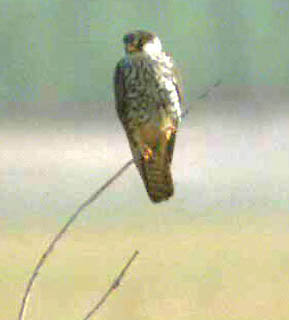
 The
first two subfamilies mentioned are restricted to the New World. There
are nine species of caracaras in the Neotropics, ranging from humid
jungles to high elevation paramo. Some caracaras are forest edge
species, often following the rivers through the lowlands and hunting
along the banks. The Black Caracara (above) is such a
bird. It is widespread in the South American lowlands; here it uses
driftwood on a Napo River islet as a hunting post.
The
first two subfamilies mentioned are restricted to the New World. There
are nine species of caracaras in the Neotropics, ranging from humid
jungles to high elevation paramo. Some caracaras are forest edge
species, often following the rivers through the lowlands and hunting
along the banks. The Black Caracara (above) is such a
bird. It is widespread in the South American lowlands; here it uses
driftwood on a Napo River islet as a hunting post. 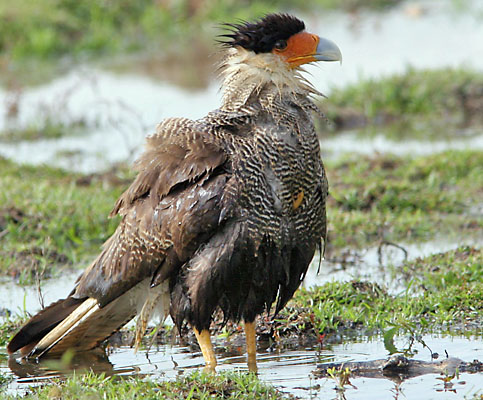
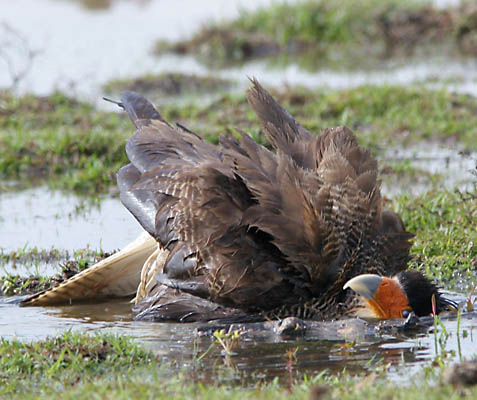
 The
8 species of forest-falcons are mostly shy birds of the forest
interior. Depending on the size of the species, they hunt for insects
and lizards to large birds and small mammals. The only member within
this subfamily not called a "forest-falcon" is the conspicuous and
striking Laughing Falcon (left). It is a forest edge
species that typical hunts from a high, open perch. They feed almost
exclusively on snakes, both terrestrial and arboreal, including large
and venomous ones (White et al. 1994).
The
8 species of forest-falcons are mostly shy birds of the forest
interior. Depending on the size of the species, they hunt for insects
and lizards to large birds and small mammals. The only member within
this subfamily not called a "forest-falcon" is the conspicuous and
striking Laughing Falcon (left). It is a forest edge
species that typical hunts from a high, open perch. They feed almost
exclusively on snakes, both terrestrial and arboreal, including large
and venomous ones (White et al. 1994). 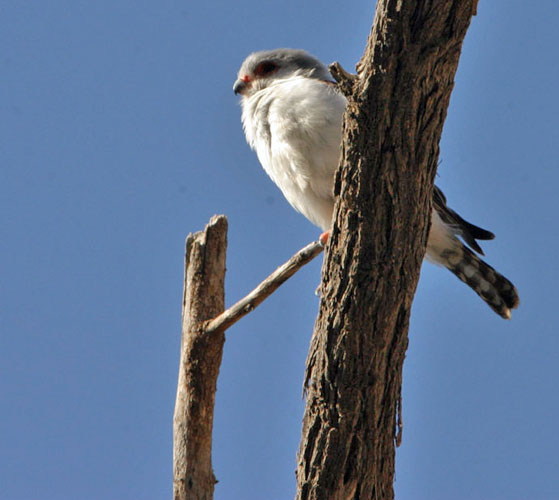
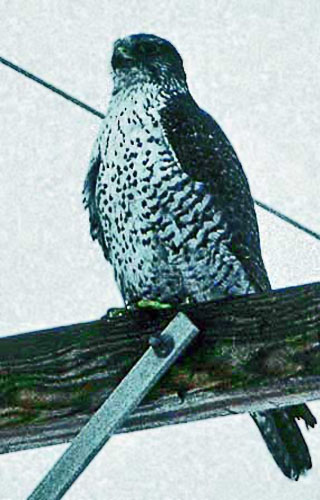
 I'm a big fan of the small, fast, mostly bird-hunting falcons, like Merlin
(above). This one was at Pt. Pinos and was just taking flight as a huge
wave crashed behind it, creating the massive spray behind. It is of the
dark northwestern North American race suckleyi, which winters here in Monterey County in small numbers.
I'm a big fan of the small, fast, mostly bird-hunting falcons, like Merlin
(above). This one was at Pt. Pinos and was just taking flight as a huge
wave crashed behind it, creating the massive spray behind. It is of the
dark northwestern North American race suckleyi, which winters here in Monterey County in small numbers. 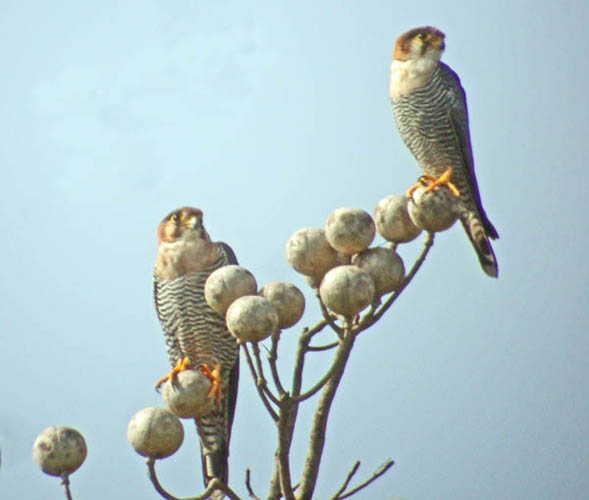
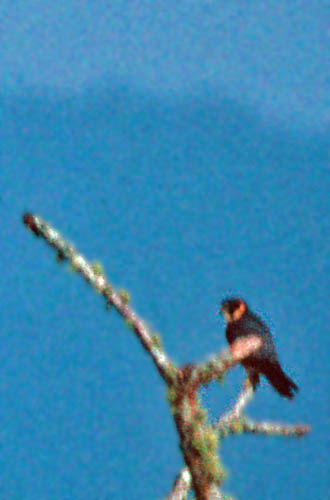
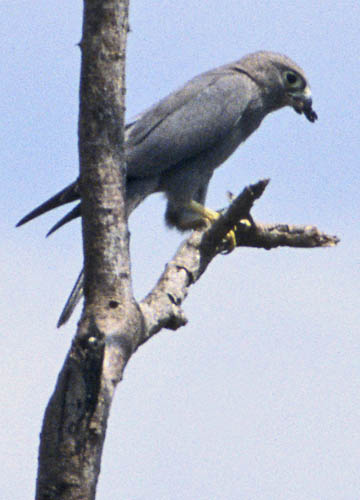
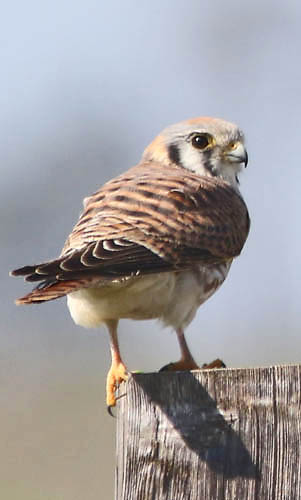
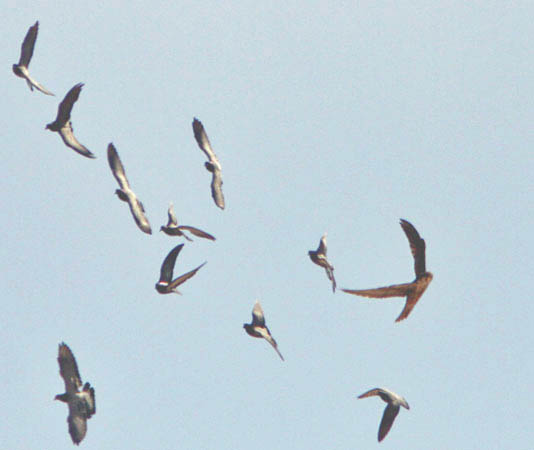

 Halfway around the world, in the United States, the large falcon of the "big sky country" of the American west is Prairie Falcon
(left). A few breed in the interior of my home Monterey County,
California, but more arrive in winter from the cold interior of the
Great Basin.
Halfway around the world, in the United States, the large falcon of the "big sky country" of the American west is Prairie Falcon
(left). A few breed in the interior of my home Monterey County,
California, but more arrive in winter from the cold interior of the
Great Basin. 